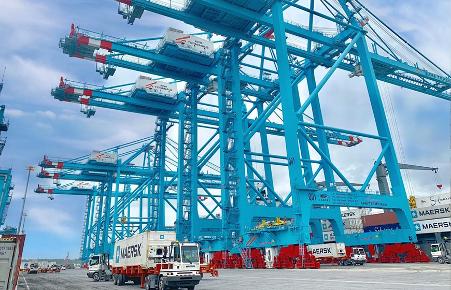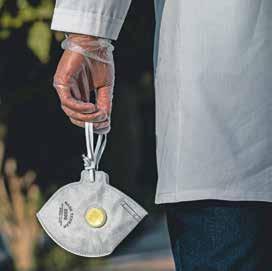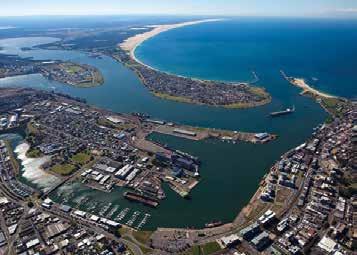
11 minute read
8 Moin Tariffs Renegotiation
Sabah ambitions | Sanctions: the risk picture | Scanning system innovation | Banana: a slippery road
COVID-19: IMPACT & ADVICE 5 Market Analysis 5 Ports: Practical Advice


Falling demand in the US, Europe and elsewhere is the next ‘big hit’ from the coronavirus with significant challenges resulting during the second quarter ‘‘
VIEWPOINT
MIKE MUNDY
Second quarter: no let up yet
The second big hit is now manifest – falling demand in Europe, the US and elsewhere. This follows on from the havoc caused to manufacturing outlets and supply chains in China after being impacted by the coronavirus. While recovery is underway in China, with manufacturers steadily ramping up production and truck driver availability climbing, attention now turns to the world’s major demand centres where COVID-19 is now strongly exerting its negative influence and will, as diverse analysts point out, be responsible for a substantial fall in demand.
Denmark-based Sea Intelligence is sticking to its earlier estimate of a 10% decline in global container shipments equating to 17 million TEU transported by shipping lines and 80 million TEU handled in the world’s container ports.
The analyst has also recently estimated a potential fall in US output in the second quarter of this year that could be as high as 24% due to a combination of the coronavirus and an oil price war. Clearly, such a scenario will impact demand and lead to a reduction in freight volumes.
The Economist Intelligence Unit (EIU) also makes a poignant statement when it says:
“The coronavirus epidemic represents a severe threat to global growth. Prior to the outbreak we expected global real GDP growth to be lacklustre this year, at 2.3% (at market exchange rates). The emergence of the epidemic in China is a game changer, and we now expect global growth of 1% this year—the slowest rate since the global financial crisis of 2008. The negative effect on growth will come via both demand and supply channels. On the one hand, quarantine measures, illness, and negative consumer and business sentiment will suppress demand. At the same time, the closure of some factories and disruption to supply chains will create supply bottlenecks.”
Specifically, in terms of regions the EIU also makes the following interesting observations with regard to Europe and Asia:
Europe: “We expect economic uncertainty to persist until at least June, dampening business sentiment, household consumption of non-essential goods, and travel and tourism activity.”
Asia: “The coronavirus outbreak will affect every economy in Asia in 2020.” It particularly cites the negative impact of a downturn in tourism with a downturn in Chinese tourism at the forefront of this. Equally, it notes as a major negative disruption to industrial supply chains with the economies with the greatest exposure to this being Hong Kong, Taiwan, South Korea, the Philippines and Thailand.
The simple fact is that according to a significant body of informed opinion the worst may not be behind us but ahead – and certainly in the second quarter of the year. After that we can hope for a ‘bounce back’ but nothing is assured yet.
EDITORIAL & CONTENT Editorial Director: Mike Mundy mmundy@portstrategy.com Guest Editor: Mike Mundy mmundy@portstrategy.com News Reporter: Rebecca Jeffrey rjeffrey@mercatormedia.com News Reporter: Rebecca Strong rstrong@mercatormedia.com Regular Correspondents: Dave MacIntyre; Iain MacIntyre; Felicity Landon; Alex Hughes; Martin Rushmere; Stevie Knight; John Bensalhia; Kate Jones; Ben Hackett; Peter de Langen; Barry Parker; Charles Haine; Charlie Bartlett; Maurice Jansen; Bob Post; Tero Hottinen
Production Ian Swain, David Blake, Gary Betteridge production@mercatormedia.com SALES & MARKETING t +44 1329 825335 f +44 1329 550192 Media Sales Manager: Tim Hills thills@portstrategy.com Media Sales Executive: Hannah Bolland hbolland@portstrategy.com Marketing marketing@mercatormedia.com
Chief Executive: Andrew Webster awebster@mercatormedia.com
PS magazine is published monthly by Mercator Media Limited, Spinnaker House, Waterside Gardens, Fareham, Hants PO16 8SD UK t +44 1329 825335 f +44 1329 550192 info@mercatormedia.com www.mercatormedia.com
Subscriptions subscriptions@portstrategy.com or subscribe online at www.portstrategy.com Also, sign up to the weekly PS E-Newsletter. 1 year’s magazine subscription £GBP184.50 UK & EURO Post area £GBP184.50 Rest of the World
©Mercator Media Limited 2020. ISSN 1740-2638 (print) ISSN 2633-4232 (online). Port Strategy is a trade mark of Mercator Media Ltd. All rights reserved. No part of this magazine can be reproduced without the written consent of Mercator Media Ltd. Registered in England Company Number 2427909. Registered office: c/o Spinnaker House, Waterside Gardens, Fareham, Hampshire, PO16 8SD, UK. Printed in the UK by Holbrooks Printers Ltd, Portsmouth, PO3 5HX. Distributed by Mail Options Ltd, Unit 41, Waterside Trading Centre, Trumpers Way, London W7 2QD, UK.


NEWS

8
28 Moin Tariffs Renegotiation Moin Container Terminal has made a strong start to operations since commencing, but government in Costa Rica now wants to renegotiate tariffs
10 Bangladesh Looks to Develop Deepwater Port The government of Bangladesh is planning to approve development of the first deep-sea port in the country, with high priority status to the project
13 CMA CGM Upbeat But May Need Cash A net loss in 2019 and the impact of COVID-19 is not deterring CMA CGM from feeling upbeat for 2020, including the role of CEVA Logistics
Cover Picture: Nathan Dumlap
Online portstrategy.com 5 Latest news 5 Comment & analysis 5 Industry database 5 Events
Weekly E-News Sign up for FREE at: www.portstrategy.com/enews
Social Media links LinkedIn PortStrategy portstrategy YouTube
15

REGULARS 16 16
15
Ports Face Key Strategy Choices
Cruise ships have become pariahs and indicative of how ports are struggling in a difficult environment at present
15
That ‘C’ Word Again and What
Can Be Done
About It?
There is no definitive answer yet to how far the virus will spread, but the industry, governments and businesses should all be ensuring they are prepared for the fight ahead
16 Lasting Effect of Coronavirus on Ports? COVID-19 underlines the case for more resilience in supply-chains, as a longer-term impact on ports is considered
FEATURES
18
18 COVID-19: Impact and Advice Coronavirus market impact and practical advice for ports
23 Sabah Ports Ambitions A regional role is seen for Sapangar Bay Container Port (SBCP)
27 Musical Chairs in Buenos Aires It’s all change once again as the political musical chairs in Argentina obliterates the plan for one new “Super terminal” at Puerto Nuevo, in Buenos Aires
38 On Cyber Crime Alert A regional role is seen for Sapangar Bay Educating staff to counter the threat of cyber -crime is essential
41 Scan and Deliver Nothing can be taken at face value when receiving containerised cargo, but modern container scanning systems mean cargo inspection is streamlined, faster and safer
54 Banana: a Slippery Road DP World’s Banana port project is experiencing pushback from the current DR Congo government
is a proud support of Greenport and GreenPort Congress
GreenPort magazine is a business information resource on how best to meet the environmental and CSR demands in marine ports and terminals. Sign up at greenport.com
The Congress is a meeting point that provides senior executives with the solutions they require to meet regulatory and operational environmental challenges. Stay in touch at greenport.com Join leading port executives in Athens, Greece from 14-16 October 2019 www.greenport.com/congress The Congress is a meeting point that provides senior executives with the solutions they require to meet regulatory and operational environmental challenges. Say in touch at greenport.com Join leading port executives in Athens, Greece from 14-16 October 2020 www.greenport.com/congress
BRIEFS
BPA virus note One useful source of information for the port industry that highlights good steps to take to reduce the impact of the coronavirus can be found via a specific Guidance Note that has been published by the British Ports Association. For more information, it can be accessed via the group’s website at https://www. britishports.org.uk/news/ wuhan-coronavirus-itspotentialimplications-onthe-uk-portssector
Restoring financial sustainability in NZ A NZ$79.4 million investment in Opotiki Harbour and NZ$8.5 million investment in West Coast South Island ports has been announced by the New Zealand Government. The new harbour is expected to stimulate significant aquaculture initiatives in the region, including mussel farming, and serve as a catalyst for private investment in marine-related industries, wharves and a residential development. Restoring financial sustainability of ports is another key aim.
JV speeds inland port development A 50/50 joint-venture partnership signed between Tainui Group Holdings (TGH) and Port of Tauranga is expected to bring the 192-hectare Ruakura Inland Port to fruition within two years. “This agreement brings clarity and certainty to the development of Ruakura Inland Port and signals we are open for business,” says TGH chief executive Chris Joblin, explaining that both parties retain a strategic interest.
BETTER ROAD AND RAIL ON IA LIST
Australian ports are being tipped for better road and rail access in the near future, according to the 2020 Infrastructure Priority List just released by Infrastructure Australia (IA).
Industry groups have welcomed a focus on freight and rail in IA’s latest output. Key projects highlighted include completing the Port Botany freight rail line duplication, preserving a corridor for a dedicated freight rail connection to the Port of Brisbane and making the Sydney Gateway project a High Priority Initiative to allow port traffic to avoid local arterial roads.
The list serves as an infrastructure investment guide for the Commonwealth and state governments and has included the National Freight and Supply Chain Strategy since 2016, which is seen as an important step in progressing the freight and logistics industry’s wish list into reality.
Australian Logistics Council CEO Kirk Coningham says it is especially pleasing to see a high degree of alignment between projects and initiatives contained on the list and priorities reflected in the National Action Plan associated with the freight strategy.
“Experience has shown that inclusion on the Infrastructure Priority List can be a catalyst for securing investment in critical projects and progressing initiatives vital to Australia’s economic interests and enhancing the liveability of our communities.
“IA’s rigorous, independent assessment process means governments, investors and the wider community can have confidence that investing in the projects and initiatives contained on the list will address genuine economic and social needs.”
Port of Newcastle CEO Craig Carmody says the list also supports the prioritisation of
8 Port of Newcastle hopes inclusion on the Infrastructure Priority List can be a catalyst for securing investment

developing suitable east coast deep-water container ports.
Mr Carmody said IA had correctly identified a major deficiency in the nation’s preparedness for ever-larger ships. “The data is clear – shipping lines around the world have stopped building the ships that Australia’s ports are designed to accommodate,” he said.
Newcastle is mounting a strong campaign to be allowed to develop a container port.
Myanmar is targeting development of the Kyuakphyu Port and Special Economic Zone, it announced during the recent visit of Chinese President Xi Jingping. China is picking much of the cost of the project.
Both countries have agreed to “push the China-Myanmar Economic Corridor (CMEC) from concept to transit, sketching into concrete development…. namely the Kyauk Phyu Special Economic Zone,” an official Myanmar communiqué said.
The two countries agreed back in 2015 to develop the facility but since then there has been little progress – hence the reference to concrete development.
Kyaukpyu has a number of attractions, especially for a China keen to ease its reliance on the Straits of Malacca. Myanmar is an ally keen to build infrastructure for its own development, although there is some resistance to Beijing’s involvement.
The project will give China a Bay of Bengal base, which neither India nor Bangladesh off and the water depth at some points at the port is said to be as much as 45m, meaning no limits on the ships that could use it.
A Chinese consortium led by the government-owned Citic Group inked a framework agreement with the Kyaukpyu Special Economic Zone Management Committee during Xi’s visit.
Crude oil and gas pipelines which have their head at the port are already supplying China, although it is still undecided what else could be developed. Complicating matters are environmental social impact assessments which are still to be done.
Local media reports have said the initial phase of the project will include two berths with a total investment price tag of $1.3 billion. A joint-venture partnership will be set up to construct and operate the port, according to one report.
Initially, the project was to be 85% funded by the Chinese consortium but, after its election, the new Myanmar government asked for a reduction in the Chinese companies’ stake in the project to 70 percent.
The key issue is whether the Kyaukpyu SEZ will increase Myanmar’s growing public debt and if Myanmar is unable to provide the financing it will most likely seek Chinese loans. PUSHING CHINA-MYANMAR CORRIDOR
Together we can of cargo handling. SHAPE THE FUTURE







EFFICIENCY IN ACTION





Together we shape the future of cargo handling, with safe and eco-efficient solutions that improve your every move. Making your every move count. Together we shape the future of cargo handling, with safe and eco-efficient solutions that improve



